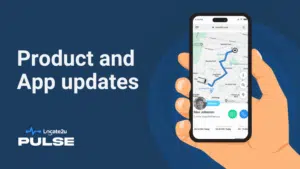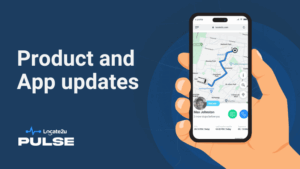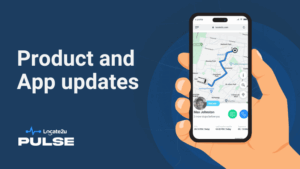The latest Locate2u core update introduces a range of features designed to optimize logistics and team management.
Locate2u Product Updates: Core 2.8.17 and 2.8.18
Locate2u Core 2.8.17 and 2.8.18 introduces several new features and enhancements aimed at improving user experience and system flexibility.
Summary
Users can now set up custom action emails for service status changes, define required fields for stop and shipment bookings, and toggle the display of source references on the trip details page.
Updates to order item displays and team member profile enhancements provide better organization and clarity.
Additionally, pagination has been added to the Frequent Address form, and order lines are now included in the order creation API response.
This release also brings refinements to system behavior, including improvements to the PDF run sheet and foundational work for an upcoming enhanced tracking link.
Several enhancements have been made to improve accuracy, UI consistency, and API responses.
These updates collectively enhance Locate2u’s functionality, providing a more seamless and efficient experience for users.
New Custom Action Email: ‘Service Status Change > Not Complete’
Feature Details:
- Introduced a new custom action email for the trigger ‘Service – Status Changed’ when the status is set to ‘Not Complete’.
- Users can configure the email to be sent to:
- A specific email address
- The Team Manager
- The email is triggered based on the services attached to a stop.
Use Case:
- When a service on a stop is marked as ‘Not Complete’, an automated email notification is sent to the relevant recipient(s), ensuring timely updates for team managers or external contacts.
Allow Teams to Define Required/Compulsory Fields for Stop or Shipment Bookings
Feature Details:
- Introduced a team setting that allows teams to define compulsory fields for bookings made via the Stop and Shipment modals on the App Portal.
- Renamed “Custom Fields” in Settings to ” Fields” to better align with this feature.
- Added two new tabs under Booking Fields:
- Stop Required Booking Fields
- Shipment Required Booking Fields
- A checkbox mechanism is introduced inside these tabs to allow teams to mark fields as required in the Add Stop and Add Shipment modals.
- Once configured, these required fields:
- Apply team-wide
- Extend to the Custom Portal (Customer Admin roles)
Use Case:
- Ensures that teams can control and standardize the data required for booking stops and shipments.
- Prevents missing critical information by enforcing required fields per team preference.
Feature: Display Source Reference on Trip Details Page > Stops Table
Description:
To improve visibility and customization, users can now choose whether to display the Locate2u Source Reference or the Stop Reference in the Stops Table on the Trip Details Page. This functionality mirrors the existing implementation on the Trips List Page.
- A toggle or dropdown allows users to switch between the two reference types.
- The user’s selection is saved so that it remains available even after a page reload.
- This setting is stored at the user level for a personalized experience.
Impacted UI Components:
- Trip Details Page → Stops Table
Use Case:
- Users who prefer to see their own stop references instead of Locate2u-generated references can now toggle their preferred view, making trip management more flexible.
Feature: Make Updates to How We Present Items/Item Lines in Orders
Description:
Currently, order item lines are displayed in the Items column on both the Orders Page and the Order Details Page. However, this approach can be confusing for customers who push specific products as items themselves rather than as item lines (e.g., Designer Transport or Prestige Furniture).
To improve clarity, we have updated the display logic to handle both scenarios effectively:
- Users will now see both items and their corresponding item lines displayed properly.
- This ensures a more intuitive and consistent user experience, regardless of how items are structured in the API.
Impacted UI Components:
- Orders Page → Items Column
- Order Details Page → Items Section
Use Case:
- Customers using the Orders API to push specific products as items will now see them clearly distinguished from item lines, reducing confusion.
- Improves the usability of the Orders Page by ensuring all item details are properly structured and visible.
Feature: Move Finance Fields to ‘Accounts’ Tab & Add ‘Documents’ Tab to Team Member Profile
Description:
- Move Finance Fields to ‘Accounts’ Tab:
- A new tab called “Accounts” is added to the Team Member Profile page.
- The following finance-related fields are moved from their existing location to this new tab:
- Company Name
- ABN/ACN
- Account Email Address
- Company Name
- A new tab called “Accounts” is added to the Team Member Profile page.
- Add ‘Documents’ Tab for Licence & Insurance Information:
- A new “Documents” tab is added to the Team Member Profile to allow users to upload team member-related documents.
- This includes fields for Driver’s Licence and Insurance Information.
- A new “Documents” tab is added to the Team Member Profile to allow users to upload team member-related documents.
- Driver’s Licence Fields:
- Licence Class (small free-text input field)
- Expiry Date (date picker)
- Licence Class (small free-text input field)
- Insurance Information Fields:
- Policy Number (small free-text input field)
- Expiry Date (date picker)
- Policy Number (small free-text input field)
- Enhancements to Team Member Export:
- The following columns are added to the Team Member Export file to support the new fields:
- Licence Class
- Licence Expiry
- Policy Number
- Policy Expiry
- Licence Class
- The following columns are added to the Team Member Export file to support the new fields:
Impacted UI Components:
- Team Member Profile Page
- New “Accounts” Tab
- New “Documents” Tab
- New “Accounts” Tab
- Team Member Export File
Use Case:
- Allows better organization of finance-related fields under a dedicated “Accounts” tab.
- Introduces a structured way to store and manage team members’ licence and insurance details.
- Ensures these details are easily exportable for reporting or compliance purposes.
Feature: Improvements – Include Pagination in Frequent Address Form
Description:
- The Frequent Address Form currently does not support pagination, causing performance issues when handling large datasets.
- Pagination will be implemented similar to Stop and Shipment Forms, with a page size of 50 records per page.
- A total count will be displayed, similar to the Review Charges Form, showing the total number of Frequent Addresses based on applied filters.
Impacted UI Components:
- Frequent Address Form
- Add pagination (50 records per page)
- Display total frequent address count based on applied filters
- Add pagination (50 records per page)
Use Case:
- Improves performance when handling large frequent address lists.
- Enhances user experience by making navigation easier and more efficient.
- Provides better visibility into the total number of addresses in the system.
Feature: Include Order Lines in GET /api/v1/orders/created Response & Add Item SKU to Order Import API
Description:
- Enhancement to GET /api/v1/orders/created API Response
- Currently, the API only returns items at the order level, excluding order lines.
- The response will be updated to include order lines, ensuring that all relevant details are available.
- Currently, the API only returns items at the order level, excluding order lines.
- Add itemSku Field to Order Import API (POST /api/v1/orders/import)
- The order import API will now support an itemSku field to allow SKU-level tracking.
- This helps better identify products during import and improves order processing accuracy.
- The order import API will now support an itemSku field to allow SKU-level tracking.
Impacted APIs:
- GET /api/v1/orders/created
- Update response structure to include order lines.
- Update response structure to include order lines.
- POST /api/v1/orders/import
- Add itemSku field to support SKU-based product identification.
Use Case:
- Order Lines Inclusion: Ensures that both items and item lines are available in the API response.
- Item SKU Addition: Enhances product identification and inventory tracking during order import.
- Improved API Flexibility: Provides a more complete dataset for integrations and reporting.
Release 2.8.18
- Improvements to PDF Run Sheet: Enhanced formatting and readability for better usability.
- Foundation for New Tracking Link: Initial groundwork laid for a powerful new tracking link with exciting features—full release details to be announced soon!
Enhancements and Improvements
- Selected areas from an existing service area were incorrectly showing when adding a new service area.
- First delivery window time details were retained even after deletion.
- Unintended menu options were visible in the mobile view.
- Max stops, max volume, max weight, and max quantity values were not clearing when deleted.
- Assigned shipment creation was blocked when a user was assigned to a team member.
- API response format for the Orders by Date endpoint was updated for consistency.
- Chatbot menu permissions were adjusted for proper access control.
- Invoice line totals now correctly reflect the quantity.



